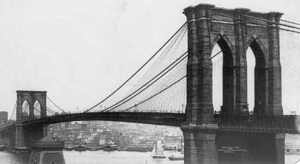January: A time to look forward — and back.
Whether you call it a “Change of Watch” or “Change of Command” or “Passing the Gavel,” January is the month of rebirth in the world of clubs and associations.
The name of the month is taken from the Roman god Janus, the protector of gates and doors, as well as beginnings and endings. Romans believed that in return for his hospitality to the great god Saturn, Janus was given the ability to see both the future and the past; and so he was depicted in their culture with two faces, one looking back and the other looking forward. Since ancient times, the month of January has been seen as a bridge between the old and the new.
It may be only a coincidence, but construction of the greatest icon of all American bridges began on January 3, 1870. Although it would take another 13 years to complete, when it opened in 1883 the Brooklyn Bridge was the longest suspension bridge in the world. It was also the first steel-wire suspension bridge, and the first bridge to connect Manhattan to Long Island. Its massive towers, each 276-feet high with distinctive arched portals support a span over a mile long that soars 135 feet above the East River.
But numbers alone don’t tell the story of the Brooklyn Bridge. Even before it was completed, it became a symbol of the greatness of New York, and a testament to the optimism Americans felt after four long years of a civil war in which the blood of their husbands, sons, brothers and nephews had stained the soil of their homeland. If Manhattan and Long Island could be joined by a bridge – an enormous bridge of one single span – then, surely, people said, anything was possible. They decided the towers were symbolic of the past and future for travelers who crossed the bridge, and that kissing while under the towers would bring good luck in the coming year.
The bridge did more than create its own folklore; it changed the way people lived. Brooklyn was home to some 400,000 residents and was considered rural in 1870. Once the bridge was completed, people poured across it to live in the clean, fresh air of western Long Island. Brooklyn Village was renamed Brooklyn Heights, and a construction frenzy began. Like it or not, the idea of the “suburb” was born, and America would never be the same.
Today Brooklyn is a thriving hub packed with 2.6 million people who would not think of living anywhere else. It is filled with high-tech startup companies and young entrepreneurs, and has become a mecca of postmodern art and design. Even the great Janus would have found it difficult to see the changes that would flow from the building of a single bridge – a bridge that today carries 145,000 vehicles per day, and, engineers say, is good for another hundred years.



I loved the Brooklyn Bridge history. I lived in NY my whole life and learned something
new…thanks to you.
Sylvia